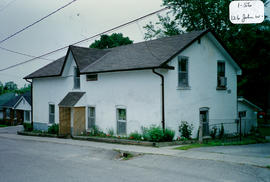- CA BWGPL GJ-HB-2017-04-21-16
- Item
- 1995
Part of George Jackson fonds
This two-storey structure is located at 218 Simcoe Road. It is the fourth house on the west side (south of the “Y” in Simcoe Road). Robert Stewart, his wife, and family lived here many years ago. His son George, who married Ethel Waldruff, played lacrosse and was a painter and paper hanger for Billie Sutton. Robert owned 75 acres of land and worked as the town clerk for 25 years. He also farmed (and later rented) his land. Ed Cave and his wife (Ida) and daughter (Violet) moved to this area from Newton Robinson and eventually bought and worked a farm. He delivered milk and had a dairy in town. Ed was a staunch Orangeman who played King Billie riding his white horse at the 12th of July parade. There was a gravel pit on the property. He eventually sold his farm to Mike Sklencar, John Kulha, Steve Brinkos and John Kashmere. They divided the remaining land and sold the lots along Simcoe Road. The large house was converted into four apartments that were used as their living quarters while they each built a house. The structure was still being used as an apartment building in 1995. (1, 2)
George Jackson










